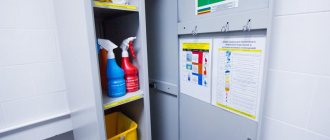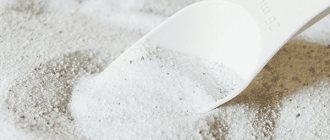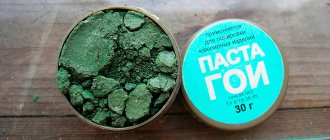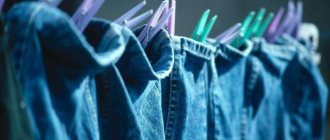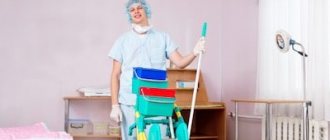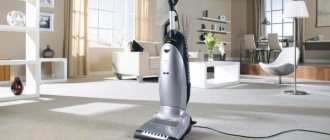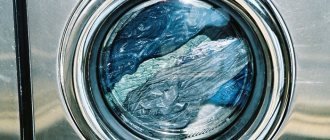Photobank Lori
According to SanPiN requirements, all cleaning equipment must be marked with certain colors, taking into account the types of cleaning work and the functional purpose of the room. It should also be stored in a specially designated room. In this case, a color-coded scheme should be placed in the inventory storage area.
What equipment is marked on?
Maintaining cleanliness and hygiene rules is the most important condition for the activities of any institutions and organizations where people are located, especially medical, children's, educational institutions, restaurants and cafes.
The proper level of cleanliness and epidemiological safety is achieved through regular cleaning and disinfection using cleaning equipment. Cleaning equipment is very diverse, but the most commonly used are:
- buckets;
- rags;
- mops,
- brushes;
- shovels;
- scrapers;
- brooms;
- napkins;
- pipe cleaners;
- containers;
- cleaning carts, etc.
All of the above equipment must be marked depending on what rooms they clean and what work they perform. This is a general requirement for all organizations and institutions. It is established by clause 2.11 of SanPiN, approved by Resolution of the Chief State Sanitary Inspector of the Russian Federation dated December 24, 2020 N 44 (SP 2.1.3678-20) (hereinafter referred to as SanPiN No. 44). So, for example, in a cafe the hall for visitors is cleaned with one tool, toilets with another, storage areas with a third, the kitchen with a fourth, etc. Labeling helps avoid inventory confusion. Thanks to this, the risk of spreading infections and harmful contaminants during cleaning is significantly reduced.
The absence of markings on cleaning equipment is the basis for claims from Rospotrebnadzor during inspection and administrative liability.
Types of cleaning
At the moment, there are 3 main types of cleaning:
Wet look
The main ingredient without which it is impossible to carry out this type of cleaning is water. Typically some amount is mixed with detergent and used to remove stains. Necessary equipment includes rags, mops, spray bottles and important wipes.
Dry type
The method does not guarantee perfect cleanliness, but it does an excellent job of removing dust and dry, fragile stains. Most cleaning is done by hand. To carry it out, you need pipi-dastras, rags, brushes, sweeping items or vacuum cleaners.
Mixed cleaning
Mixed cleaning
This type of dirt removal contains both dry and wet types of cleaning. The implementation uses water, detergents suitable for specific surfaces, as well as substances that can disinfect and kill germs.
In addition, it is customary to divide cleaning into several classifications according to the frequency of their implementation. Thus, there are also 3 types.
- Daily or routine cleaning of the premises;
- Weekly removal of dirt;
- Spring-cleaning.
Important! According to the method of implementation, cleaning can be divided into manual and mechanical.
- The first type involves removing stains using hand brooms, brushes, mops, rags and dustpans.
- And the second type allows the use of automatic devices that greatly simplify the process. The equipment includes vacuum cleaners that can be equipped with a dust collector or an aqua filter. In addition, there are washing devices that actively perform wet cleaning of contaminants. The range of mechanical cleaning items may include steam generators and sweeping and washing machines.
Marking methods
SanPiN No. 44 does not prescribe to the heads of organizations exactly how they should label cleaning equipment. Typically color coding and/or text labels are used. The organization independently chooses the appropriate method.
Color coding
It is most convenient to indicate inventory by color. There are two ways to provide color coding:
- initially purchasing cleaning equipment of different colors for different rooms and areas;
- apply color coding yourself, for example, with oil paint of different colors or colored stripes if we are talking about rags, bags, etc.
There is no generally accepted color coding regulation. Each organization independently decides what colors it will use to mark its inventory. In any case, it is better to use contrasting bright colors rather than shades of them: for example, blue/red/yellow/green, but not blue/cyan/violet. This will allow employees not to confuse the colors.
The most common color coding option is:
- Red color: often used in high-risk areas with heavy contamination (toilets, waste areas).
- Green color: as a rule, used in rooms with high requirements for cleanliness (kitchens, canteens, production areas).
- Blue color: areas with low risk and minor contamination (visitor reception, halls).
- Yellow color: other rooms.
If the organization uses color coding, then a coding scheme must be placed in the inventory storage area.
Text labels
Color codes are not the only way to mark cleaning equipment. You can also use text inscriptions, for example: “For the floor”, “For the windows”, “Dining room”, “Hall”, etc. Inscriptions can be applied with paint, markers, or laser. The most important thing is that they are clear and easy to read.
Please note that it is best not to use marking methods such as tape, stickers, tags, etc., as this increases the risk of contamination and the transfer of harmful bacteria.
Labeling requirements according to SanPiN
The current SanPiN No. 44 does not contain specific requirements for the labeling of cleaning equipment. The basic rule is that marking, in principle, should be and should be carried out depending on the purpose of the premises and the type of work (washing windows, washing floors, surfaces).
It is especially emphasized that cleaning equipment used in toilets must be separately labeled and stored separately from other equipment. Everything else - marking methods, colors used - is left to the organization itself.
SanPiN requirements
In SanPiN for beauty salons and hairdressing salons 2.1.2.2631-10, the requirements for equipment are described briefly:
- Different equipment is used to clean different groups of rooms. Different groups are a division according to purpose - bathroom, main rooms, auxiliary areas;
- Markings are placed on the inventory indicating the type of work and premises;
- equipment is used only in accordance with the labeling;
- After cleaning, all used equipment is washed, disinfected, dried and put away in a designated place.
Since sanitary requirements for beauty salons and hairdressing salons often overlap with the requirements for medical institutions, let’s look at SanPiN 2.1.3.2630-10. It says about the inventory:
- the inventory must be clearly coded or color-coded;
- a color coding scheme is placed where the inventory is stored - in a closet or a separate room;
- Different equipment is used for walls and floors. Likewise with offices, corridors and bathrooms;
- You can store equipment in a separate closet or room. The main thing is not in work areas.
The same requirements for medical organizations specify uniforms.:
- Employees must have special clothing for cleaning. The set includes the clothing itself - a robe and cap, and protective elements - a mask, gloves, an apron;
- After cleaning, personnel must change their overalls to work clothes.
In general, in all matters that are not covered in SanPiN 2.1.2.2631-10 for beauty salons and hairdressing salons, you should contact SanPiN 2.1.3.2630-10 for medical institutions. Often the requirements are spelled out in more detail.
You shouldn’t be guided by the principle “it’s not written in SanPiN, so it doesn’t matter” - Rospotrebnadzor employees have a different view of this situation.
Sanitary standards for beauty salons, manicures, hairdressers. Updated requirements 2021
Let's summarize - for a beauty salon we need several sets of labeled equipment - separately for walls and floors, separately for different groups of rooms - work area, utility rooms and corridors, bathrooms.
Details about cleaning:
How to clean a beauty salon
Nuances of labeling in medical institutions
In hospitals and clinics, strict procedures for the use of cleaning equipment, including their careful labeling, are aimed at preventing the spread of nosocomial infections.
Sanitary standards for the activities of medical institutions are contained in SanPin No. 44 (section IV). There are no special requirements for the labeling of cleaning equipment, so general rules apply: separate use of equipment in different rooms and by type of work.
Typically, in medical organizations, cleaning equipment is marked using color coding as follows:
- red: cleaning bathrooms;
- blue color: cleaning wards, staff rooms;
- green color: cleaning dressing rooms and treatment rooms;
- yellow color: cleaning of utility rooms.
Download! Restroom Cleaning Schedule: Sample Form
To enlarge the picture, click on it
To enlarge the picture, click on it
To enlarge the picture, click on it
To enlarge the picture, click on it
To enlarge the picture, click on it
Nuances of labeling in catering
Just like in medical institutions, in restaurants, cafes and canteens the risks of spreading infections are quite high. Here the sanitary standards and rules approved by the Resolution of the Chief State Sanitary Doctor of the Russian Federation dated October 27, 2020 N 32 “On approval of sanitary and epidemiological rules and norms (SanPiN 2.3/2.4.3590-20) must be observed.” The marking of cleaning equipment is discussed in clause 2.19, according to which separate marked equipment must be allocated for cleaning industrial and sanitary premises, and cleaning equipment for the toilet must be stored separately from equipment for cleaning other premises.
As you can see, the same general rules apply here as in other institutions and organizations.
Equipment needed for cleaning
Cleaning equipment
When cleaning the house, people usually use the equipment that is most convenient and practical for them. This rule does not apply to public enterprises. Employees are required to purchase items and means for washing and cleaning, which are prescribed in the regulations.
Each individual item must contain a marker explaining the purpose of the inventory. For example, on a mop for washing the floor in a ward it is necessary to indicate that the item is suitable only for the floor in patients’ rooms.
Each institution must have:
- mop for cleaning floors in corridors and stairs;
- mop for cleaning toilets and bathrooms;
- different mops for different rooms;
- buckets;
- mops with attachments;
- rags, brushes, rags, napkins and sponges for various needs and various types of surfaces;
- trolleys for transporting equipment. They allow you to move indoors and transport necessary items and devices.
Nuances of labeling in educational institutions
Properly organized cleaning in educational institutions - kindergartens and schools - is of particular importance, because it is the key to children’s health. These organizations have their own sanitary rules (SanPin SP 2.4.3648-20), approved by Resolution of the Chief State Sanitary Inspector of the Russian Federation dated September 28, 2020 No. 28.
Clause 2.11.3 of the said SanPiN essentially duplicates the provisions of SanPiN No. 44, indicating the mandatory labeling of cleaning equipment by cleaning zones and types of work. There are no special requirements for its labeling in schools and kindergartens. Standard color coding is used.
In the winter period of the year, including in connection with the seasonal increase in the incidence of influenza and ARVI, the issue of compliance with standardized microclimate parameters (temperature, relative humidity, air speed) in educational institutions for children and adolescents (schools, kindergartens) is especially relevant.
As a result of human activity, substances released from skin, dirty clothes, and food debris enter indoor air; The temperature and humidity of the air rise, and the concentration of carbon dioxide increases. If there are sick children in a group or class, then when they cough or sneeze, viruses and bacteria get into the air.
There is always dust in the air of enclosed spaces; along with the air, dust particles enter the child’s respiratory tract and mechanically irritate the mucous membrane, which is more delicate than in adults.
The degree of air quality is directly dependent on the number of children and the duration of their stay in the room.
Humidity and air speed are very important in the heat exchange between a child and the environment. Both high and low humidity have a negative effect on the child’s body. To maintain optimal air conditions in the premises of children's organizations, it is important to regularly remove exhaust air and replace it with outside air.
Ventilation
School
All rooms must be ventilated daily.
Educational rooms are ventilated during breaks, and recreational rooms are ventilated during lessons.
Before the start of classes and after their completion, it is necessary to carry out through ventilation of the premises (if there are 2 shifts of training - after each shift).
Kindergartens
Airing in groups is carried out for at least 10 minutes every 1.5 hours in the absence of children, and ends 30 minutes before they arrive from a walk or class. In the bedrooms, cross-ventilation is carried out before children are put to bed.
The duration of through ventilation is determined by weather conditions, wind direction and speed, and the efficiency of the heating system. When airing, a short-term decrease in the air temperature in the room is allowed, but not more than 2°C.
Physical education lessons and sports sections should be conducted in well-aerated rooms.
Through ventilation of premises in the presence of children, ventilation through toilet rooms is not allowed.
With good heating, efficient operation of the ventilation system, and proper organization of room ventilation, it is not difficult to ensure the standard microclimate parameters. This means that children, being in an educational organization in comfortable conditions, will be less susceptible to diseases, including infectious ones.
Wet cleaning
Wet cleaning in educational institutions, its frequency and quality also plays a big role in the prevention of ARVI.
Schools
All premises of educational institutions are subject to daily wet cleaning using detergents.
Toilets, dining rooms, lobbies, and recreation areas are subject to wet cleaning after each break.
Cleaning of educational and auxiliary premises is carried out after the end of lessons , in the absence of students, with windows or transoms open.
If a general education organization works in two shifts, cleaning is carried out at the end of each shift: floors are washed, places where dust accumulates are wiped (window sills, radiators, etc.)
The premises of a boarding school at a general education organization are at least once a day.
To carry out cleaning and disinfection in general education organizations and boarding schools at general education organizations, they use detergents and disinfectants that are approved in accordance with the established procedure for use in children's institutions, following the instructions for their use.
Disinfectant solutions for cleaning floors are prepared before direct use in restrooms in the absence of students.
Disinfectants and detergents are stored in the manufacturer’s packaging, in accordance with the instructions, in places inaccessible to students.
At least once a month, general cleaning is carried out in all types of premises of a general education organization and boarding school at a general education organization.
General cleaning by technical personnel (without involving the labor of students) is carried out using approved detergents and disinfectants.
Exhaust ventilation grilles are cleaned of dust monthly.
Kindergartens
In the catering area
daily:
— washing floors, removing dust and cobwebs, wiping radiators and window sills;
weekly
— washing walls using detergents, lighting fixtures, cleaning glass from dust and soot.
once a month
— general cleaning followed by disinfection of all premises, equipment and inventory.
All premises of the kindergarten are cleaned using a wet method using detergents at least 2 times a day with open transoms or windows, with mandatory cleaning of places where dust accumulates (floors near baseboards and under furniture, window sills, radiators, etc.) and frequently dirty surfaces ( door handles, cabinet handles, switches, hard furniture, etc.).
Wet cleaning:
Sleeping - after night and daytime sleep,
Group meals - after every meal.
Gym - once a day and after each lesson. After each lesson, air for at least 10 minutes. Sports equipment is wiped daily with a damp cloth, mats - using a soap-soda solution. Carpets are cleaned daily using a vacuum cleaner .
Carpets daily and cleaned with a damp brush or knocked out in specially designated areas in the utility area, then cleaned with a damp brush.
Sanitary equipment is disinfected daily, regardless of the epidemiological situation.
General cleaning of all premises and equipment is carried out once a month using detergents and disinfectants.
Windows outside and inside are washed as they become dirty, but at least 2 times a year (spring and autumn).
When all of the above measures are carried out, the likelihood of acute respiratory viral infections among children is sharply reduced.
The procedure for storing used cleaning equipment
Whatever organization we are talking about, all cleaning equipment must be disinfected, rinsed and dried after use. Rags, napkins and rags are washed and then dried.
Cleaning equipment is stored in a specially designated place (room or closet), and equipment for each zone is stored separately. The area of such a room (cabinet) must be at least 2 square meters. m (Appendix 2 to SanPin No. 44).
If there is a separate room for storing equipment, it is advisable to equip it with cold and hot water supply, washing machine, heated towel rails, taps, etc.
Results
Labeling cleaning equipment helps prevent cross-spread of pathogenic bacteria and viruses from one room to another and thereby ensure the proper level of cleanliness and safety in the organization. Typically, color coding or text inscriptions are used for marking.
Features of the new sanitary rules
The new requirements for catering are based on several key principles.
Taking into account various factors
SanPiN prescribes requirements taking into account biological, chemical, physical and other factors.
Biological factors include microbiological and parasitic contamination, the proliferation of pathogenic microorganisms. To prevent these risks, employees must comply with a number of requirements and adhere to strict rules when organizing their work process.
In particular, they are required to report cases of intestinal infections in their relatives with whom they live. Employees must also use disposable gloves when preparing cold appetizers and salads. If the integrity of the gloves is compromised, they should be replaced with new ones.
To eliminate biological factors, you need to adhere to the rules when distributing and selling food. For example, ready-made meals that require heating before consumption should not be served for more than three hours from the moment of production. Prepared meals cannot be frozen and sold the next day.
Sauces for dishes are served in individual consumer packaging.
Chemical factors include pollution with toxic substances. To prevent them from getting into products, detergents and disinfectants must be used according to instructions and stored in special places.
Caterers are not allowed to use mercury thermometers.
Physical factors include thermal effects. The rules state that the temperature of hot dishes, cold soups, and drinks sold through distribution must comply with technological documents.
Presumption of good faith
The new rules are based on HACCP principles. This abbreviation translates from English as hazard analysis and critical control points.
Catering enterprises are given the opportunity to independently control their activities. But they need to implement the HACCP system (developed for a specific enterprise) and write down all the instructions and requirements. Ignoring this condition may result in fines under Art. 14.43 Code of Administrative Offences.
Advantages of new sanitary rules for small businesses
The new SanPiN softens some requirements for small establishments that are not designed for high flows of visitors. The defining feature in this case is the number of seats. If you have less than 25, then you can count on relaxations.
- One toilet is allowed for visitors and staff. But at the same time, its entrance must be isolated from production and storage facilities.
- It is possible to store raw and finished products in one refrigerator. But there is a condition: it must be in closed containers.
The requirement to hire separate personnel to clean the toilet has disappeared from the new rules, which is important for micro-businesses for which an extra employee entails additional expenses. This duty can be performed by other employees, the main thing is to comply with safety standards.
